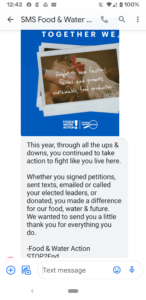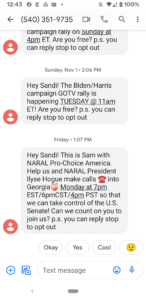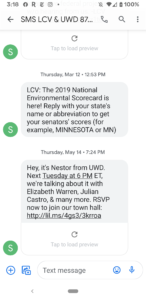Important Changes to the Text Messaging Requirements in 2020
There is no denying that this year due to the confluence of the U.S. Census collection, the 2020 Election, and the COVID19 Pandemic the use of text messaging (SMS/MMS) as an outreach, fundraising, and marketing tool reached new heights. With this increase in text messaging nonprofit organizations, political campaigns, corporations, and scammers have drawn the attention of the two major regulating entities. The Federal Communications Commission (FCC) and the CTIA, the trade association that represents the mobile industry. Here are some major changes that were implemented this year or will be fully enforced in 2021.
FCC Declares that Peer-to-Peer Texting Not Accountable to the TCPA
The FCC delivered good news this year with their ruling that peer-to-peer texting is not considered an Automatic Telephone Dialing System (ATDS) under the TCPA. Peer-to-peer texting which began in 2016 is used to message targeted audiences without the recipients’ consent or opt-in, but requiring the message sender individually hits send on every message sent. Until this ruling, it existed in a grey area with uncertainty if organizations using peer-to-peer outreach could be regulated or fined by the FCC for TCPA violations.
For those not familiar with the Telephone Consumer Protection Act (TCPA). It regulates text messages considered Application-to-Person (A2P) which means an autodialer technology platform sends the messages, not an individual person. A2P is also known as broadcast texting or being able to send one message to thousands at once. Anyone receiving these types of messages:
- MUST Consent to receive text communications from the organization/sender
- MUST be provided all legal disclaimer in the “Call-to-Action” or “Ask” and in the first message they receive from the sender.
- Text STOP to Quit, HELP for Information. Msg&DataRatesMayApply. Recurring Messages.
These legal requirements are also enforced by the CTIA. The main difference in regulatory power is that the FCC can fine for every violation (which can add up), whereas the CTIA can stop all your messages from even being delivered. The news in July 2020 that the Trump Campaign’s peer-to-peer fundraising messages were blocked as a result of several consumer complaints being investigated for being texted without an opt-in. My sources within the telecommunications industry informed me that this campaign was sending texts that appeared to be peer-to-peer messages from a local phone number (ie. long code), but they were actually sent from an autodialer platform.
CTIA Tightens It’s Reigns on Text Messaging Due to Consumer Complaints
With the increase in messaging, carriers have seen a growing number of consumer spam complaints indicating individuals are  getting frustrated with opening up their phones to a message they never opted into. The worst thing for a campaign to discover is that only 70% or less of their messages were actually received by the intended recipient. No one wants money, time, and capacity misused or wasted. The CTIA released in September 2020 several key areas (via Twilio) they would be cracking down on:
getting frustrated with opening up their phones to a message they never opted into. The worst thing for a campaign to discover is that only 70% or less of their messages were actually received by the intended recipient. No one wants money, time, and capacity misused or wasted. The CTIA released in September 2020 several key areas (via Twilio) they would be cracking down on:
-
Not receiving consent to text.
Traffic, as identified by increasing customer complaints, that shows evidence of not gaining appropriate opt-in.
- This ONLY applies to A2P/Autodialer/Broadcast Text Messaging, which requires an opt-in from the recipient of the messages. This opt-in could be via a webform or keyword opt-in path and if audited the organization would need to prove this. If complaints are also filed with the FCC an audit will be done and every text sent without an opt-in can lead to a fine for each text.
-
Clear Opt-Out/STOP Language in ALL Outgoing Texts.
 Informational and promotional text messaging traffic failing to have a clear description of how to opt-out, meaning STOP language is not clearly shown to the end-user. As a reminder, conversational traffic is consumer-initiated and does not require including STOP language in each response. So this only applies to the initial texts sent by an organization. You may have noticed that right around Election Day the shortcode (six-digit number) broadcast mobile lists you are subscribed to (who likely use the Upland Mobile Commons platform) started including “Text STOP to Quit” or some variation in their text messages.
Informational and promotional text messaging traffic failing to have a clear description of how to opt-out, meaning STOP language is not clearly shown to the end-user. As a reminder, conversational traffic is consumer-initiated and does not require including STOP language in each response. So this only applies to the initial texts sent by an organization. You may have noticed that right around Election Day the shortcode (six-digit number) broadcast mobile lists you are subscribed to (who likely use the Upland Mobile Commons platform) started including “Text STOP to Quit” or some variation in their text messages. - This originally only applied to A2P/Broadcast Texting, but due to the huge increase in P2P texts sent in 2020, it is being monitored by the carriers for peer-to-peer texting as well.
- P2P: This does increase opt-outs, especially when texting cold audiences who are not familiar with your organization or campaign. It is not required that you include the opt-out language, but it could put your campaign at risk of having your messages blocked.
- A2P: This simply ensures that your warm list wants to hear from you and is aware that they can unsubscribe at any time, similar to the CANSPAM required to unsubscribe language in the footer of an email.
-
Traffic using URL shorteners with public domains rather than custom or private domains owned by the company.
- This applies to any type of mass text messaging (A2P and P2P) and URL shortening tools that can be used for free anywhere on the internet, like Bit.ly. There are ways to purchase your own private short domain and link it to a tool like rebrandly.
- For peer-to-peer text messaging we’ve found that it is better to include any short link (ideally private, not public) in the second message versus the initial text to avoid messages being blocked by the carriers.
-
Traffic that appears to be snowshoe messaging – a technique used to spread messages across senders for the purposes of overcoming filtering systems (full definition available in the CTIA Guidelines).
- This technique is primarily used by text messaging platforms that are using long codes or local phone numbers to send A2P or Broadcast texts. These platforms will tell you that by sending 200 messages at a time from multiple numbers they can get around the carriers filters that block A2P/Autodialer messages being sent from long codes. They are wrong. At least half or more of your messages will likely get blocked.
The CTIA’s Messaging Principles and Best Practices Guide provides an in-depth view of the community’s focus on helping the messaging ecosystem maintain its identity as a trusted and convenient communications environment.
Shared Shortcodes Are Being Banned . . . Slowly

As of this year, AT&T was joined by TMobile announcing that they will no longer be approving new shared shortcodes for use on their carrier networks. So right now, existing shared shortcodes can continue to operate, but they are being phased out to make room for 10DLC, which will be industry approved long codes for A2P texting. Unfortunately, not all carriers have introduced 10DLC as an option yet, so it is not the best idea to switch until it is adopted by all the carriers.
The decision to phase out Shared Shortcodes is also is partly due to increased spam complaints and the difficulty of penalizing bad actors on a shared shortcode without also harming the good actors. Typically when complaints come in about a shortcode the number is shutdown which hurts those other organizations who are on it.
Several platforms have offered shared shortcodes, including Upland Mobile Commons, EZTexting, Simple Texting, etc. They are holding on to the fact that the use of shared shortcodes for charities (501c3 nonprofit organizations), Emergency notifications, 2FA / OTP, and Transit Alerts have been made exceptions or grandfathered in. But, this year Upland Mobile Commons has been recommending that its customers on shared shortcodes begin to migrate to a dedicated shortcode if they can afford it.
Definitely keep all of these changes in mind as you plan your mobile programs for 2021 and beyond.